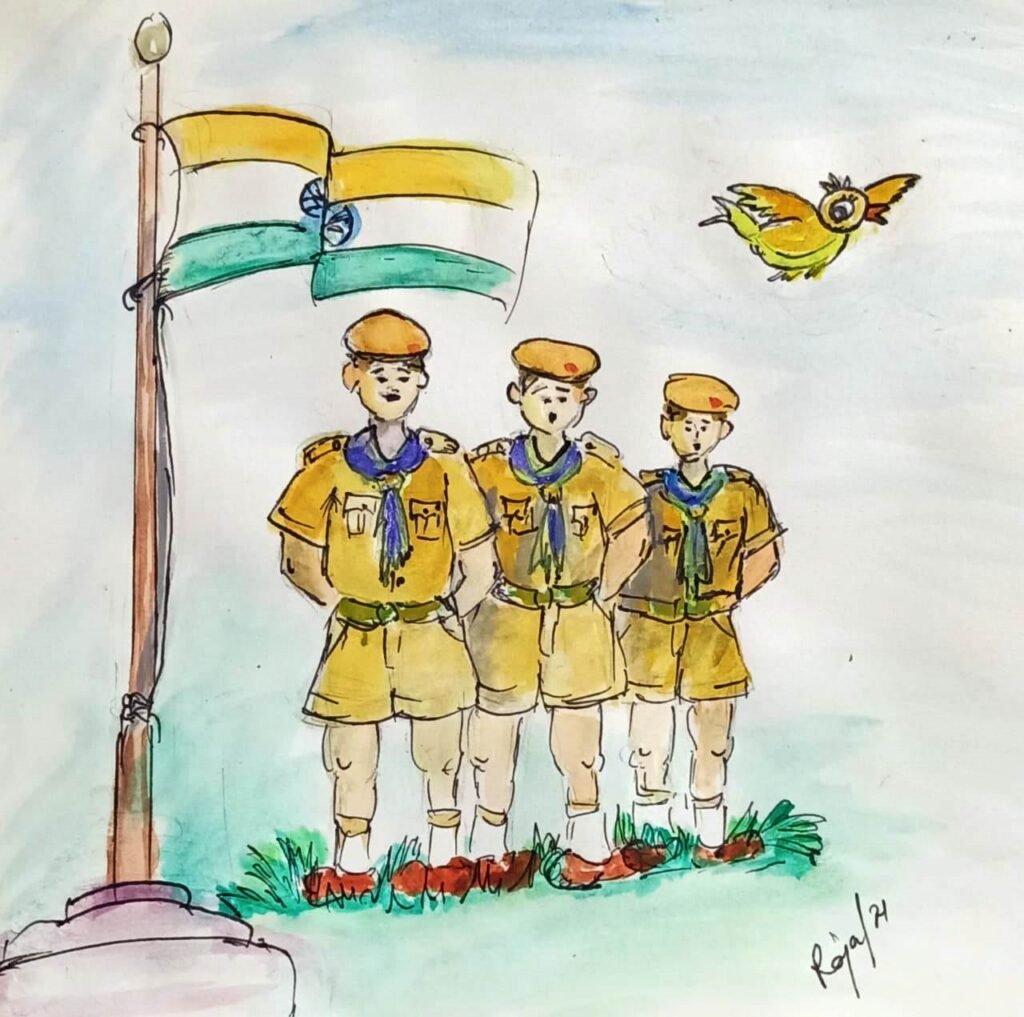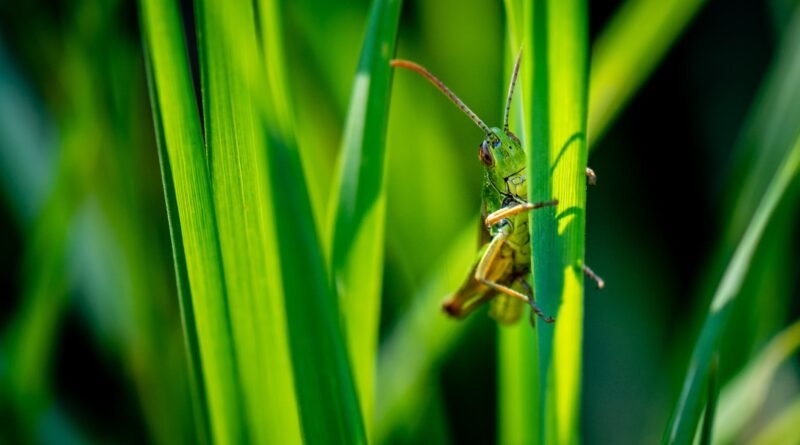Grasshopper Chronicle Chapter 8 (I)
Grasshopper Chronicle Chapter 8 (I)
Reef Knot: The Knot for life
Jyotirmoy Prodhani
As we came to class VI, our objective of life was to join either NCC or Boys Scout. The boys with roll numbers one Jaideep, roll number two Durlabh and also roll numbers three, four, five and six and even nine and eleven were all in Boys Scout. So we realised that to be in the Boys Scout would automatically mean, no matter what your roll number was, it would go without saying that you were a good student. Most of us joined Boys Scout and the many of them joined the NCC. The NCC ones were mostly the stout lot. The NCC instructor, Jung Bahadur, would keep shouting at them the way ploughmen shout at the bulls, or the buffalo cart drivers would yell at the buffaloes.

Father took me to Mukul Darji to sew a new pair of Boys Scout uniform – khaki half shirt with two breast pockets with covers and shoulder loops, khaki shorts with buttoned loops for the belts and also the blue triangular scarf. Then from the school we bought belt, socks, beret and the woggle to run it through the two ends of the blue scarf around our necks. The woggles were not available in the normal shops. They were small cream coloured plastic drums with both sides open so that the two ends of the triangular scarf around our necks could run through it and be held neatly. From outside we bought brown pairs of canvas shoes. Sir said to buy Bata canvas shoes. There was only one Bata shoe shop at Dhubri but no such shop at Golakganj. Most of us bought BSC canvas shoes from Brajen Dutta’s shop. I told father, ‘Sir said to buy only Bata shoes, I will not buy this.’ Brajen Datta told my father, ‘Dada it is the same thing. BSC means Bata Shoe Company. In the show rooms to earn more profit they call the shoes as Bata shoes. In the other shops the same Bata shoes are sold as BSC shoes at a lower price. The usual company tricks, you see.’ My father was completely convinced and was happy to have bought the same Bata shoes at a lower price. He then told me, ‘See, they are the same Bata shoes, same quality.’
Now the important accessory we were to manage was not available in the shops -the bamboo stick. At least five from my class who enrolled in Boys Scout came to our house to get the bamboo sticks. We together, along with Sombaru, went to our bamboo grove to choose the best bamboo to make our sticks. It was a thick bamboo grove. This was the place from where the foxes used to howl at night. Our ducks and the kids of our goats were always at danger following those foxes. They said foxes lived inside the holes under the ground. There must have been plenty of holes inside the bamboo grove. We looked for the fox holes, the fox burrows, but could discover none. We followed Sombaru instead. He asked, ‘How many sticks do you want?’ We counted ourselves and said, ‘Six.One extra’. He cut two long bamboos with a dao. The bamoboos fell on the nearby bamboo and now it was our turn to pull out the hacked bamboos reclining on the adjacent ones. All of us grabbed one of the bamboos and pulled it, but it would not move apart from making the other bamboos to swing down and up. It was like a tug of war with the bamboos. We would pull it a bit then the bamboo would go back. The long and slim leafy branches of the bamboo would get entangled with the branches of the other bamboo trees, It took a lot of force and time to tug out the bamboos from inside the grove. Sombaru scoffed at us, ‘What you boys eat huh, that you guys don’t even have the strength of a hungry crow? Must eat a lot of milk and athia kol and then only you can cut and drag a bamboo like a real man.’ None of us liked athia kol, the thick, stubby bananas with a lot of annoying seeds inside. Sombaru had trimmed the bamboos by cutting off the leafy branches, and then we together dragged the bamboos to our front yard. He made six brand new, straight and sturdy bamboo sticks, almost as tall as us. That as Scouts we were to carry sticks, we found that to be a great idea, we immediately felt quite powerful. Jaideep said, ‘We are not supposed to use the sticks for fighting but for protecting others and ourselves.’ Jaideep was the first boy in our class, so he always said good good things. Manoj said, ‘Whatever it is, we must apply raw mustard oil on the sticks to make it really tough and dangerous.’ We liked this idea; we immediately started the process of seasoning the sticks with robust coats of raw mustard oil.
The parade sessions used to be after the school hours. The NCC boys would drill in the school ground in front and we would be having our sessions under the mango tree in the back. In the beginning of the class we were made to stand together, put our hands one above the other and take the Scout pledge:
‘On my honour I will my best to my duty, to God and to my country, and to obey the scout law, to help other people at all times, to make myself physically strong, mentally awake and morally straight.’
On our first day, after the pledge Sir asked us to shake hands with one another. As we started shaking hands vigorously and had turned that into quite a fun game, Sir stopped us and said, ‘This is not the way a scout should shake hands.’ He then said, ‘Boys Scout always shake their hands with their left hands and not with the right one and one must not keep shaking hands just like that, you must shake for two and a half time-first down, second down, up and release the grips.’ We were a bit confounded, found difficult to figure out.
-‘Now tell me why it is so?’ Sir asked.
The senior ones were told not to tell the answer. Manoj, who had also joined the Boys Scout instead of NCC, replied the tricky question, ‘Sir it is because to keep our right hands clean so that there is no problem while eating.’ Everybody giggled. Sir then said, ‘We the Boy Scouts shake hands with our left hands because it is in the left side of our chest where we have our hearts.’ Almost all of us, quite spontaneously, placed our right hands on the left side of our chest, for a kind of verification whether our hearts were still beating.
We then sat on the ground in a circle. We were in front of our Boys Scout teacher, Nipen Sir. (His actual name was Nripendranath, but nobody called him by that name. even other Sirs used to call him as Nipen) The senior scouts were sitting beside Nipen Sir. He asked us, ‘Do you know who the founder of Boys Scout was?’ Nobody opened their mouth. Sir answered his own question, ‘The founder of Boys Scout was Sir Robert Baden Powell. Write down in your note books.’ We searched for a useless page from our copies to write that name. Nipen Sir mildly admonished us, ‘When you come to the Scout class, you must carry a special note book. There are so many things to be written down. You will also get points for the best maintenance of your note book.’ He then asked us, ‘You know where it started?’ None of us opened our mouth. He then said, ‘It started in London, England. And now it is the biggest movement in the world.’ We wrote down those things in our note books. We felt good that we were inside the world’s biggest movement. He continued, ‘Scout is not for only physical training and parades, it is about learning the lessons of life, to build your character and moral foundation. Also it teaches you how to face the challenges of life; no matter where you are, if you are a Boy Scout, you would know how to survive even in the most difficult of situations, be it in a wild jungle or in the middle of an ocean.’ Such things sounded little scary. He then taught us about the significance of the Scout emblem, a lotus like image with three petals. He asked us to draw that image. We began to draw that emblem as gorgeously as we could. After a while practical session began. We were taught how to tie the knots. After using the rope we were also taught how to roll up the rope. Once rolled up the rope looked like a small stick covered by a coil of rope. We hung it in the loops of our shorts that looked like long key chains dangling from our waist. The first knot we were taught was ‘reef knot’. Sir said, ‘This is the easiest of knots, but this is the most useful in life.’
When we were taking down notes, learning how to tie the knots- reef knots, clove hitch and stuff – in the other field, the NCC boys were pounding the ground with robust steps: ‘Left, right, left…left, right, left’.

Jyotirmoy Prodhani
Professor, Dept of EnglishNEHU, Shillong




